Operations Report: Analysis of Hydro Tasmania's Operations
VerifiedAdded on 2023/01/19
|9
|2162
|27
Report
AI Summary
This report provides a comprehensive analysis of Hydro Tasmania's operations, focusing on its commitment to sustainable energy production. The report begins with an overview of the company, its establishment in 1929, and its role as a major producer of renewable energy in Tasmania. It delves into the company's daily operations, highlighting the processes involved in power generation from hydro, wind, and solar sources, and the strategic management of its resources, including economic and human resource aspects. The report examines Hydro Tasmania's ethical considerations, emphasizing its contribution to environmental sustainability and its alignment with community needs. Furthermore, it explores the company's value chain, sourcing of materials, and the effectiveness of its functional departments. The analysis also covers the company's strategic plans, its contribution to the sustainability of small-scale businesses, and its recognition as a suitable partner for various businesses. The report concludes by summarizing Hydro Tasmania's operations, emphasizing its commitment to environmental sustainability and its role in providing renewable energy solutions.
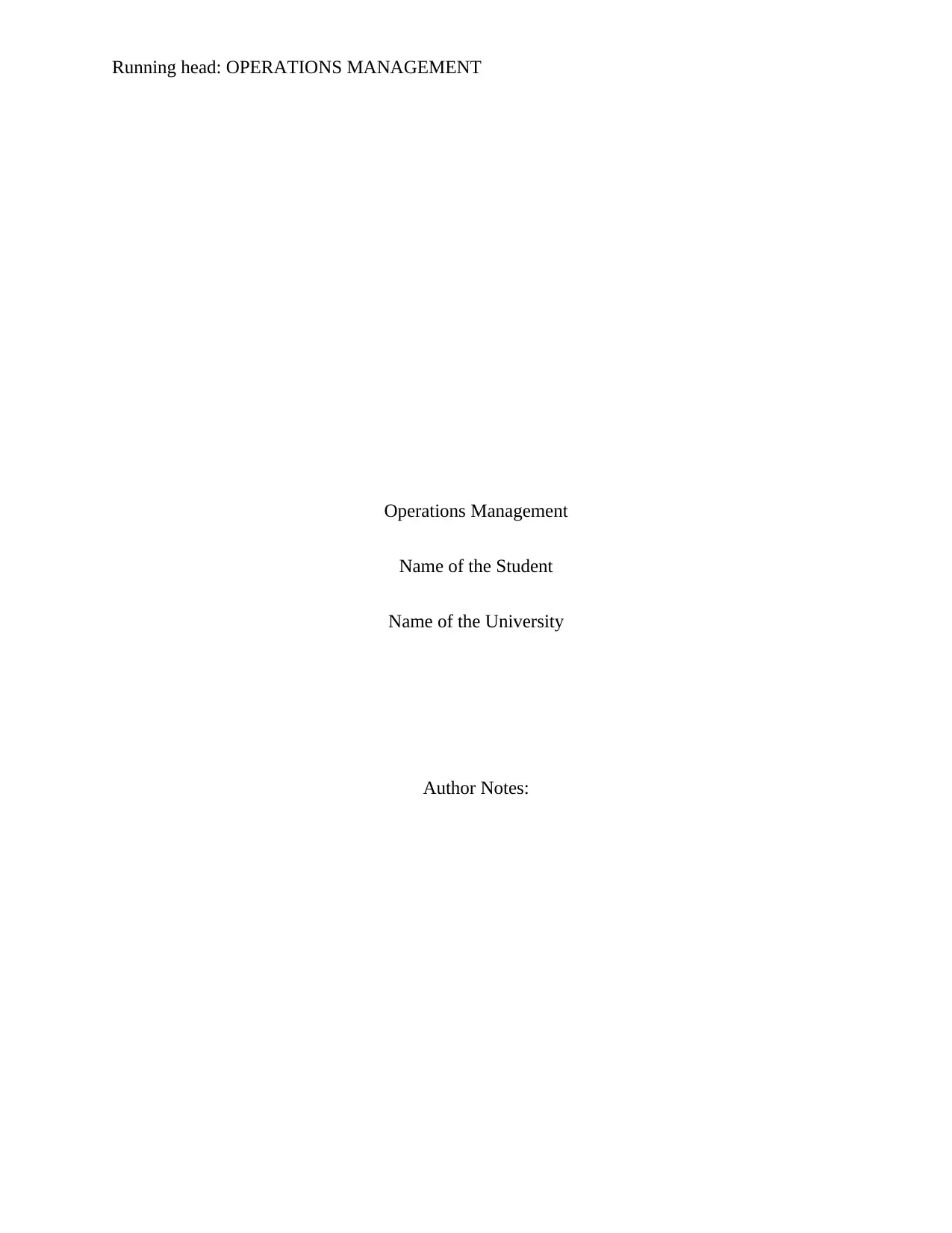
Running head: OPERATIONS MANAGEMENT
Operations Management
Name of the Student
Name of the University
Author Notes:
Operations Management
Name of the Student
Name of the University
Author Notes:
Paraphrase This Document
Need a fresh take? Get an instant paraphrase of this document with our AI Paraphraser
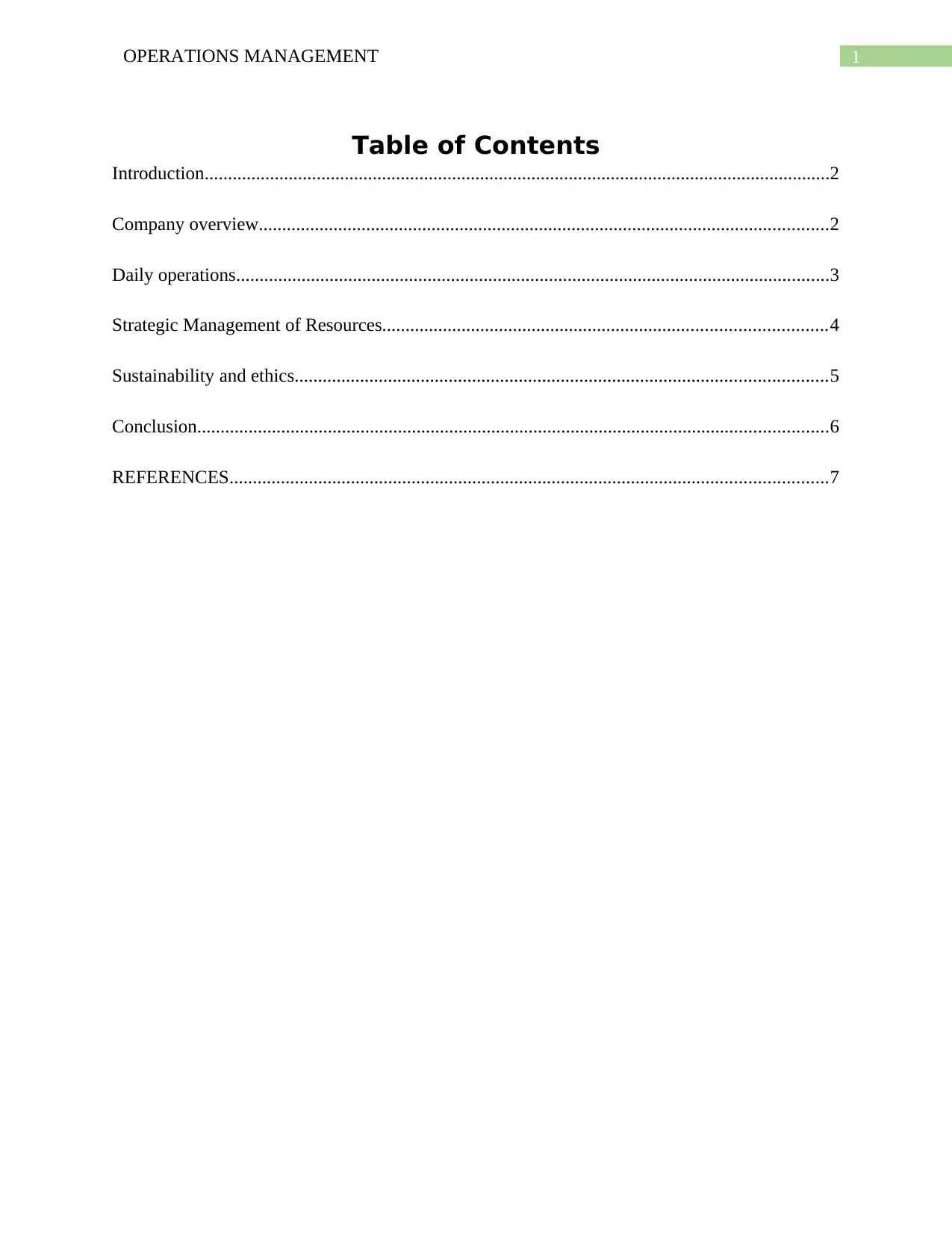
1OPERATIONS MANAGEMENT
Table of Contents
Introduction......................................................................................................................................2
Company overview..........................................................................................................................2
Daily operations...............................................................................................................................3
Strategic Management of Resources...............................................................................................4
Sustainability and ethics..................................................................................................................5
Conclusion.......................................................................................................................................6
REFERENCES................................................................................................................................7
Table of Contents
Introduction......................................................................................................................................2
Company overview..........................................................................................................................2
Daily operations...............................................................................................................................3
Strategic Management of Resources...............................................................................................4
Sustainability and ethics..................................................................................................................5
Conclusion.......................................................................................................................................6
REFERENCES................................................................................................................................7
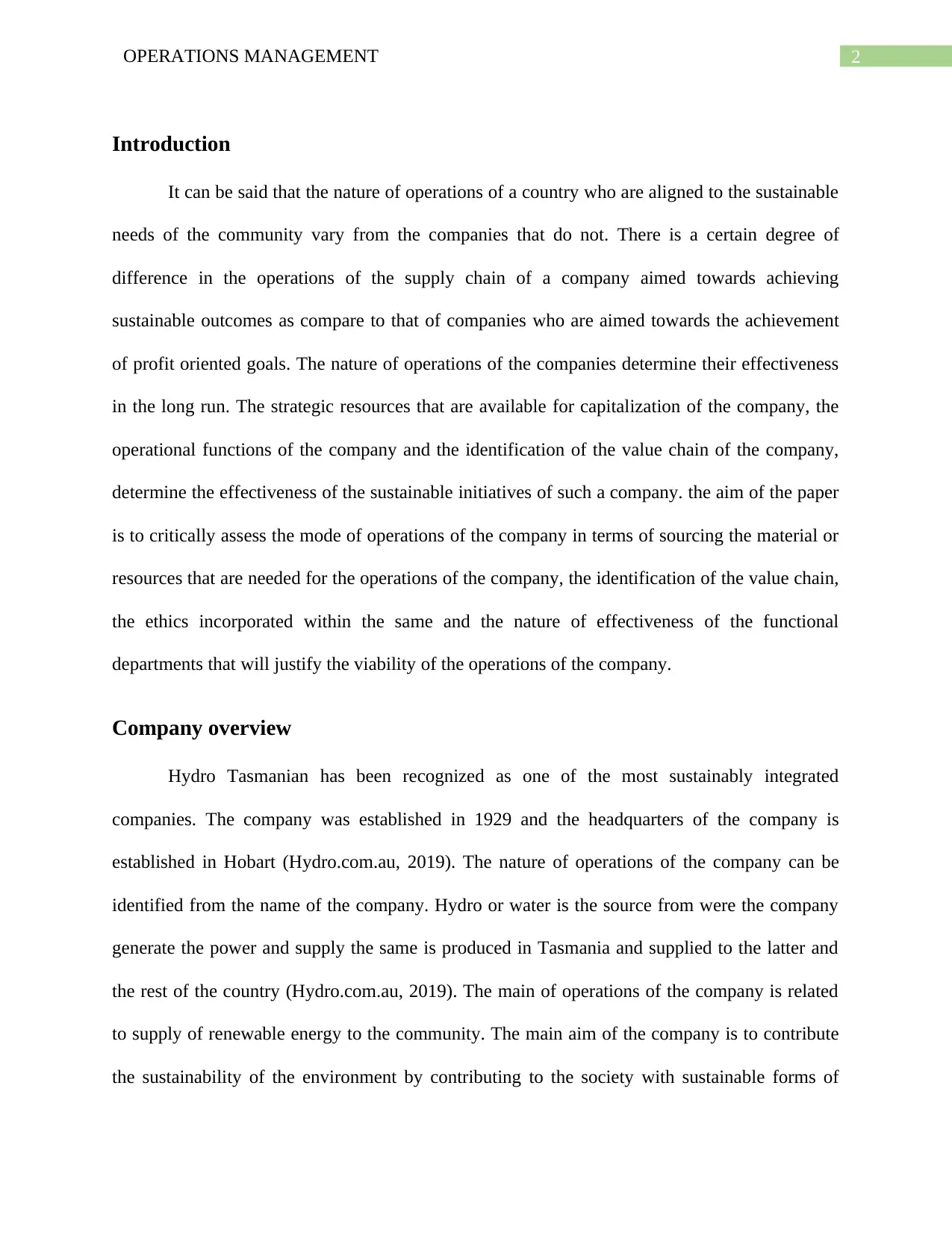
2OPERATIONS MANAGEMENT
Introduction
It can be said that the nature of operations of a country who are aligned to the sustainable
needs of the community vary from the companies that do not. There is a certain degree of
difference in the operations of the supply chain of a company aimed towards achieving
sustainable outcomes as compare to that of companies who are aimed towards the achievement
of profit oriented goals. The nature of operations of the companies determine their effectiveness
in the long run. The strategic resources that are available for capitalization of the company, the
operational functions of the company and the identification of the value chain of the company,
determine the effectiveness of the sustainable initiatives of such a company. the aim of the paper
is to critically assess the mode of operations of the company in terms of sourcing the material or
resources that are needed for the operations of the company, the identification of the value chain,
the ethics incorporated within the same and the nature of effectiveness of the functional
departments that will justify the viability of the operations of the company.
Company overview
Hydro Tasmanian has been recognized as one of the most sustainably integrated
companies. The company was established in 1929 and the headquarters of the company is
established in Hobart (Hydro.com.au, 2019). The nature of operations of the company can be
identified from the name of the company. Hydro or water is the source from were the company
generate the power and supply the same is produced in Tasmania and supplied to the latter and
the rest of the country (Hydro.com.au, 2019). The main of operations of the company is related
to supply of renewable energy to the community. The main aim of the company is to contribute
the sustainability of the environment by contributing to the society with sustainable forms of
Introduction
It can be said that the nature of operations of a country who are aligned to the sustainable
needs of the community vary from the companies that do not. There is a certain degree of
difference in the operations of the supply chain of a company aimed towards achieving
sustainable outcomes as compare to that of companies who are aimed towards the achievement
of profit oriented goals. The nature of operations of the companies determine their effectiveness
in the long run. The strategic resources that are available for capitalization of the company, the
operational functions of the company and the identification of the value chain of the company,
determine the effectiveness of the sustainable initiatives of such a company. the aim of the paper
is to critically assess the mode of operations of the company in terms of sourcing the material or
resources that are needed for the operations of the company, the identification of the value chain,
the ethics incorporated within the same and the nature of effectiveness of the functional
departments that will justify the viability of the operations of the company.
Company overview
Hydro Tasmanian has been recognized as one of the most sustainably integrated
companies. The company was established in 1929 and the headquarters of the company is
established in Hobart (Hydro.com.au, 2019). The nature of operations of the company can be
identified from the name of the company. Hydro or water is the source from were the company
generate the power and supply the same is produced in Tasmania and supplied to the latter and
the rest of the country (Hydro.com.au, 2019). The main of operations of the company is related
to supply of renewable energy to the community. The main aim of the company is to contribute
the sustainability of the environment by contributing to the society with sustainable forms of
⊘ This is a preview!⊘
Do you want full access?
Subscribe today to unlock all pages.

Trusted by 1+ million students worldwide

3OPERATIONS MANAGEMENT
energy. The energy that is provided by the company is renewable in nature and the strategic
plans that are devised by the company help in contributing to the sustainability issues of the
society. The company employs over 1100 people in the country and 750 among the employees of
the company are Tasmanians (Hydro.com.au, 2019). The company has been recognized as one
the largest producers of electricity from renewable resources. The annual power generation of the
company is around 9000-gigawatt hour of energy (Hydro.com.au, 2019). The power that is
generated by the companies is considered to be enormous as the energy is sourced from
renewable forms of energy. the power is generated by capitalizing the innovation that has been
successfully carried out by the company. the energy is sourced from wind energy and solar
panels. Other than energy, the company produces wind energy and gas. The company has more
than 30 power stations throughout the country and 2600 watts of power is supplied by the
company direct to the residence of the people (Hydro.com.au, 2019). The company has been
contributing to the sustainability of various small-scale businesses in the country and has been
chosen as the suitable partner for many businesses in the country.
Daily operations
The operations of a Hydro Tasmania go through various stages on a regular basis
(Bahadori, Zahedi & Zendehboudi, 2013). It is the role of the people associated with the
operations of the company to ensure that they are taking care of each component of the plan that
is associated with smooth functioning of the plants. There are several duties that entrusted upon
the operators in the power plant (Zhang et al., 2013). From, controlling the power generation
equipment to selection of the resources that are necessary to incorporate smooth functioning of
the former ensures that the operations among in the power generation plan goes smoothly. A
regular process of monitoring is carried out regularly to ensure the proper functioning of the
energy. The energy that is provided by the company is renewable in nature and the strategic
plans that are devised by the company help in contributing to the sustainability issues of the
society. The company employs over 1100 people in the country and 750 among the employees of
the company are Tasmanians (Hydro.com.au, 2019). The company has been recognized as one
the largest producers of electricity from renewable resources. The annual power generation of the
company is around 9000-gigawatt hour of energy (Hydro.com.au, 2019). The power that is
generated by the companies is considered to be enormous as the energy is sourced from
renewable forms of energy. the power is generated by capitalizing the innovation that has been
successfully carried out by the company. the energy is sourced from wind energy and solar
panels. Other than energy, the company produces wind energy and gas. The company has more
than 30 power stations throughout the country and 2600 watts of power is supplied by the
company direct to the residence of the people (Hydro.com.au, 2019). The company has been
contributing to the sustainability of various small-scale businesses in the country and has been
chosen as the suitable partner for many businesses in the country.
Daily operations
The operations of a Hydro Tasmania go through various stages on a regular basis
(Bahadori, Zahedi & Zendehboudi, 2013). It is the role of the people associated with the
operations of the company to ensure that they are taking care of each component of the plan that
is associated with smooth functioning of the plants. There are several duties that entrusted upon
the operators in the power plant (Zhang et al., 2013). From, controlling the power generation
equipment to selection of the resources that are necessary to incorporate smooth functioning of
the former ensures that the operations among in the power generation plan goes smoothly. A
regular process of monitoring is carried out regularly to ensure the proper functioning of the
Paraphrase This Document
Need a fresh take? Get an instant paraphrase of this document with our AI Paraphraser
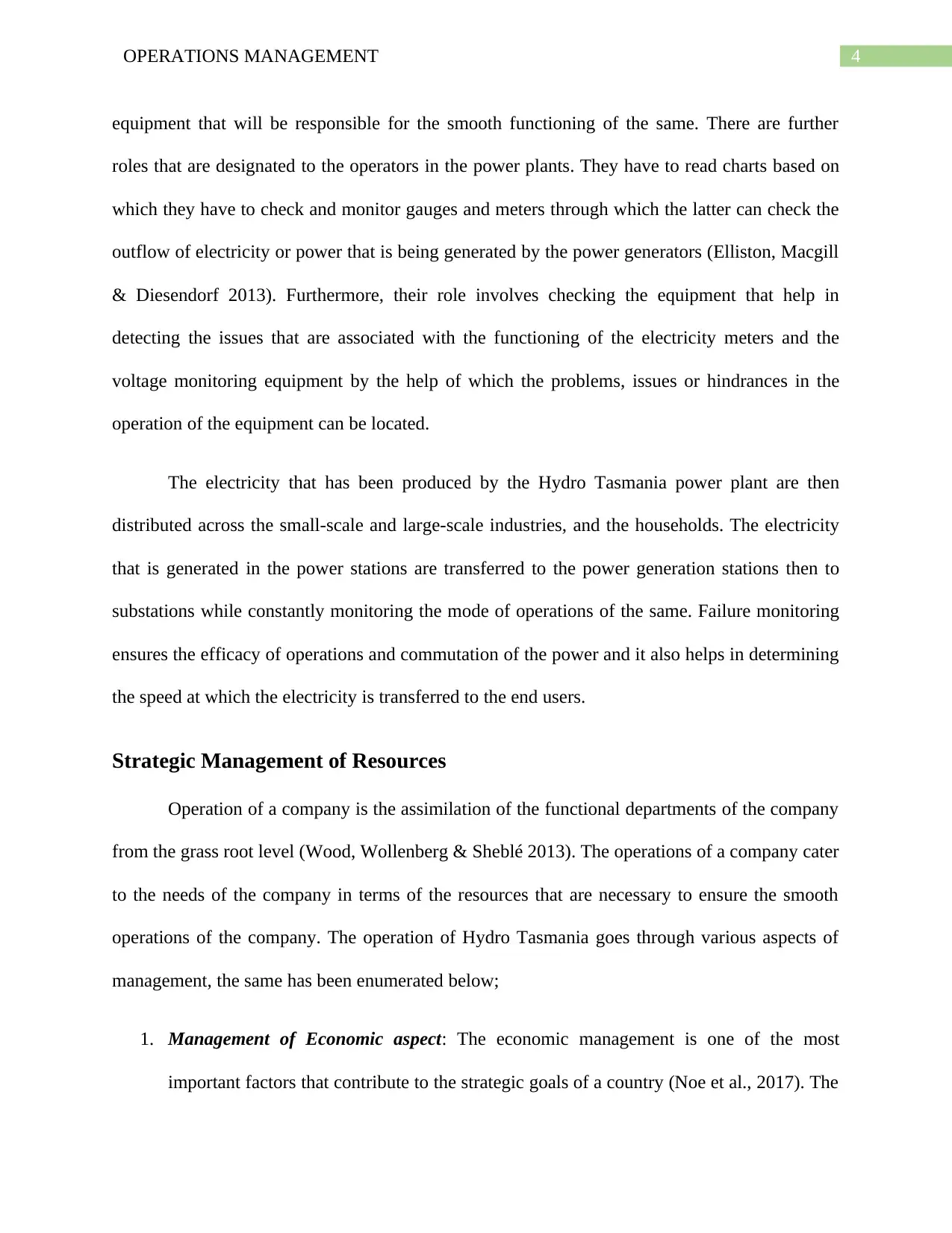
4OPERATIONS MANAGEMENT
equipment that will be responsible for the smooth functioning of the same. There are further
roles that are designated to the operators in the power plants. They have to read charts based on
which they have to check and monitor gauges and meters through which the latter can check the
outflow of electricity or power that is being generated by the power generators (Elliston, Macgill
& Diesendorf 2013). Furthermore, their role involves checking the equipment that help in
detecting the issues that are associated with the functioning of the electricity meters and the
voltage monitoring equipment by the help of which the problems, issues or hindrances in the
operation of the equipment can be located.
The electricity that has been produced by the Hydro Tasmania power plant are then
distributed across the small-scale and large-scale industries, and the households. The electricity
that is generated in the power stations are transferred to the power generation stations then to
substations while constantly monitoring the mode of operations of the same. Failure monitoring
ensures the efficacy of operations and commutation of the power and it also helps in determining
the speed at which the electricity is transferred to the end users.
Strategic Management of Resources
Operation of a company is the assimilation of the functional departments of the company
from the grass root level (Wood, Wollenberg & Sheblé 2013). The operations of a company cater
to the needs of the company in terms of the resources that are necessary to ensure the smooth
operations of the company. The operation of Hydro Tasmania goes through various aspects of
management, the same has been enumerated below;
1. Management of Economic aspect: The economic management is one of the most
important factors that contribute to the strategic goals of a country (Noe et al., 2017). The
equipment that will be responsible for the smooth functioning of the same. There are further
roles that are designated to the operators in the power plants. They have to read charts based on
which they have to check and monitor gauges and meters through which the latter can check the
outflow of electricity or power that is being generated by the power generators (Elliston, Macgill
& Diesendorf 2013). Furthermore, their role involves checking the equipment that help in
detecting the issues that are associated with the functioning of the electricity meters and the
voltage monitoring equipment by the help of which the problems, issues or hindrances in the
operation of the equipment can be located.
The electricity that has been produced by the Hydro Tasmania power plant are then
distributed across the small-scale and large-scale industries, and the households. The electricity
that is generated in the power stations are transferred to the power generation stations then to
substations while constantly monitoring the mode of operations of the same. Failure monitoring
ensures the efficacy of operations and commutation of the power and it also helps in determining
the speed at which the electricity is transferred to the end users.
Strategic Management of Resources
Operation of a company is the assimilation of the functional departments of the company
from the grass root level (Wood, Wollenberg & Sheblé 2013). The operations of a company cater
to the needs of the company in terms of the resources that are necessary to ensure the smooth
operations of the company. The operation of Hydro Tasmania goes through various aspects of
management, the same has been enumerated below;
1. Management of Economic aspect: The economic management is one of the most
important factors that contribute to the strategic goals of a country (Noe et al., 2017). The

5OPERATIONS MANAGEMENT
policies are implemented in the company in a certain way. The economic management of
the company complies with the five-year corporate plan of the government of Tasmania.
2. Human Resource Management: The human resource policies in the company abide by
the Fair work act 2009 (Macdonald & Charlesworth, 2013). Discrimination is not
tolerated in the organization and there are policies related to awareness against the same.
The company’s Human Resource policies have been able to contribute to the
sustainability of the employees and thus have been recognized as suitable employer. This
helps in gaining employee engagement, which results in achievement of the strategic
goals of the company (Breevaart et al., 2014).
3. Product management: The products that are offered by the company is in the form of
electricity. The nature of the product makes it risky for use (Wang, 2013). Thus, the
company has to go through various safety standards that are associated with the
consumption of the products. They have been able to maintain teams who are responsible
for ensuring the safety of the end users of the power that is supplied by the power plant,
along with the assets such as power generation centers, hydro pumps, dams and others.
The power or product that is supplied by the company certified by the Essential Services
Commission. Furthermore, the products and services that are offered by the company are
subject to regulations, legislative requirements and standards that the company is seen to
abide by.
Sustainability and ethics
The nature of operations of the company are deemed to be ethical in nature. The services
that are offered by the company help in solving the problems associated with scarcity of
electricity while contributing to environmental sustainability issue. It has been seen that power
policies are implemented in the company in a certain way. The economic management of
the company complies with the five-year corporate plan of the government of Tasmania.
2. Human Resource Management: The human resource policies in the company abide by
the Fair work act 2009 (Macdonald & Charlesworth, 2013). Discrimination is not
tolerated in the organization and there are policies related to awareness against the same.
The company’s Human Resource policies have been able to contribute to the
sustainability of the employees and thus have been recognized as suitable employer. This
helps in gaining employee engagement, which results in achievement of the strategic
goals of the company (Breevaart et al., 2014).
3. Product management: The products that are offered by the company is in the form of
electricity. The nature of the product makes it risky for use (Wang, 2013). Thus, the
company has to go through various safety standards that are associated with the
consumption of the products. They have been able to maintain teams who are responsible
for ensuring the safety of the end users of the power that is supplied by the power plant,
along with the assets such as power generation centers, hydro pumps, dams and others.
The power or product that is supplied by the company certified by the Essential Services
Commission. Furthermore, the products and services that are offered by the company are
subject to regulations, legislative requirements and standards that the company is seen to
abide by.
Sustainability and ethics
The nature of operations of the company are deemed to be ethical in nature. The services
that are offered by the company help in solving the problems associated with scarcity of
electricity while contributing to environmental sustainability issue. It has been seen that power
⊘ This is a preview!⊘
Do you want full access?
Subscribe today to unlock all pages.

Trusted by 1+ million students worldwide

6OPERATIONS MANAGEMENT
generation plants in general emit a high amount of waste and by products while operating.
Furthermore, it has been noticed that the companies who generate power use non renewable
sources of energy to generate power are likely to gain appreciation from the community (Kerr et
al., 2015). The mode of operations of Hydro Tasmania is completely different as they pay
importance to the environmental protection aspect. It can be said that if a company is directly
aligned with the sustainable aims in terms of environment welfare, they are likely to gain support
from the consumers, and the regulatory bodies and also gain attention government of the country
or state that they are operating in (Tilman & Clark 2014). Furthermore, the company has policies
that ensure the well-being of the employees of the organization and have frameworks through
which the can provide products safely to the consumer community. Thus, the initiatives of the
company and the nature of operations of the same are deemed to a competitive advantage for the
company.
Conclusion
On a concluding note, it can be said that the nature of operations of Hydro Tasmania are
aimed as sustainable development of the environment. The power that they generate is sourced
from hydro generators and wing turbines. There are high degrees of regulations that are
associated with the smooth functioning of the organisation in terms of achieving the strategic
goals of the company. It has also been witnessed that effective monitoring is required in daily
operations of the power plants which is further carried out even during the distribution of the
same.
generation plants in general emit a high amount of waste and by products while operating.
Furthermore, it has been noticed that the companies who generate power use non renewable
sources of energy to generate power are likely to gain appreciation from the community (Kerr et
al., 2015). The mode of operations of Hydro Tasmania is completely different as they pay
importance to the environmental protection aspect. It can be said that if a company is directly
aligned with the sustainable aims in terms of environment welfare, they are likely to gain support
from the consumers, and the regulatory bodies and also gain attention government of the country
or state that they are operating in (Tilman & Clark 2014). Furthermore, the company has policies
that ensure the well-being of the employees of the organization and have frameworks through
which the can provide products safely to the consumer community. Thus, the initiatives of the
company and the nature of operations of the same are deemed to a competitive advantage for the
company.
Conclusion
On a concluding note, it can be said that the nature of operations of Hydro Tasmania are
aimed as sustainable development of the environment. The power that they generate is sourced
from hydro generators and wing turbines. There are high degrees of regulations that are
associated with the smooth functioning of the organisation in terms of achieving the strategic
goals of the company. It has also been witnessed that effective monitoring is required in daily
operations of the power plants which is further carried out even during the distribution of the
same.
Paraphrase This Document
Need a fresh take? Get an instant paraphrase of this document with our AI Paraphraser
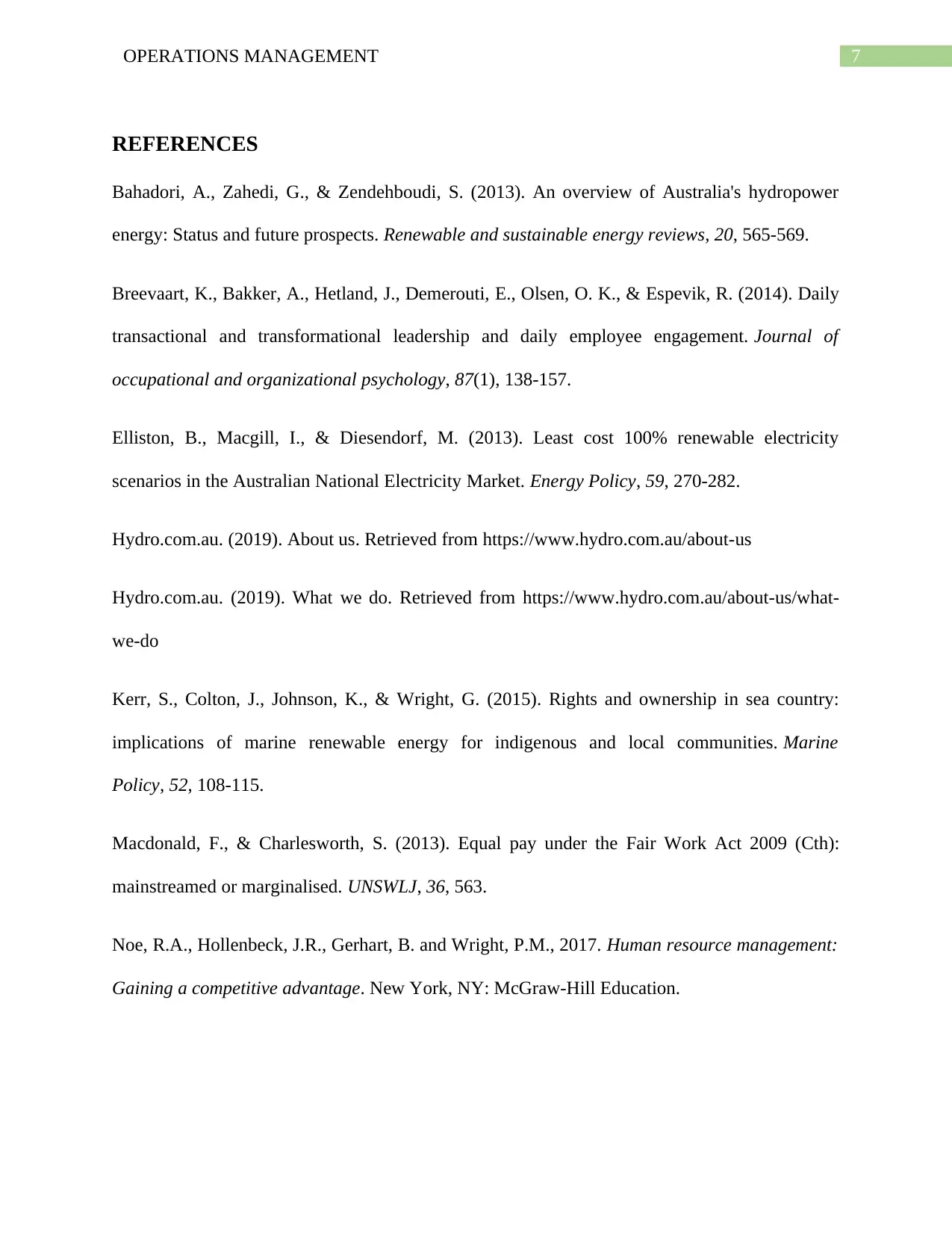
7OPERATIONS MANAGEMENT
REFERENCES
Bahadori, A., Zahedi, G., & Zendehboudi, S. (2013). An overview of Australia's hydropower
energy: Status and future prospects. Renewable and sustainable energy reviews, 20, 565-569.
Breevaart, K., Bakker, A., Hetland, J., Demerouti, E., Olsen, O. K., & Espevik, R. (2014). Daily
transactional and transformational leadership and daily employee engagement. Journal of
occupational and organizational psychology, 87(1), 138-157.
Elliston, B., Macgill, I., & Diesendorf, M. (2013). Least cost 100% renewable electricity
scenarios in the Australian National Electricity Market. Energy Policy, 59, 270-282.
Hydro.com.au. (2019). About us. Retrieved from https://www.hydro.com.au/about-us
Hydro.com.au. (2019). What we do. Retrieved from https://www.hydro.com.au/about-us/what-
we-do
Kerr, S., Colton, J., Johnson, K., & Wright, G. (2015). Rights and ownership in sea country:
implications of marine renewable energy for indigenous and local communities. Marine
Policy, 52, 108-115.
Macdonald, F., & Charlesworth, S. (2013). Equal pay under the Fair Work Act 2009 (Cth):
mainstreamed or marginalised. UNSWLJ, 36, 563.
Noe, R.A., Hollenbeck, J.R., Gerhart, B. and Wright, P.M., 2017. Human resource management:
Gaining a competitive advantage. New York, NY: McGraw-Hill Education.
REFERENCES
Bahadori, A., Zahedi, G., & Zendehboudi, S. (2013). An overview of Australia's hydropower
energy: Status and future prospects. Renewable and sustainable energy reviews, 20, 565-569.
Breevaart, K., Bakker, A., Hetland, J., Demerouti, E., Olsen, O. K., & Espevik, R. (2014). Daily
transactional and transformational leadership and daily employee engagement. Journal of
occupational and organizational psychology, 87(1), 138-157.
Elliston, B., Macgill, I., & Diesendorf, M. (2013). Least cost 100% renewable electricity
scenarios in the Australian National Electricity Market. Energy Policy, 59, 270-282.
Hydro.com.au. (2019). About us. Retrieved from https://www.hydro.com.au/about-us
Hydro.com.au. (2019). What we do. Retrieved from https://www.hydro.com.au/about-us/what-
we-do
Kerr, S., Colton, J., Johnson, K., & Wright, G. (2015). Rights and ownership in sea country:
implications of marine renewable energy for indigenous and local communities. Marine
Policy, 52, 108-115.
Macdonald, F., & Charlesworth, S. (2013). Equal pay under the Fair Work Act 2009 (Cth):
mainstreamed or marginalised. UNSWLJ, 36, 563.
Noe, R.A., Hollenbeck, J.R., Gerhart, B. and Wright, P.M., 2017. Human resource management:
Gaining a competitive advantage. New York, NY: McGraw-Hill Education.

8OPERATIONS MANAGEMENT
Tilman, D., & Clark, M. (2014). Global diets link environmental sustainability and human
health. Nature, 515(7528), 518., M. (2014). Global diets link environmental sustainability and
human health. Nature, 515(7528), 518.
Wang, Q. (2013). Risk-based security-constrained optimal power flow: Mathematical
fundamentals, computational strategies, validation, and use within electricity markets., Q.
(2013). Risk-based security-constrained optimal power flow: Mathematical fundamentals,
computational strategies, validation, and use within electricity markets.
Wood, A. J., Wollenberg, B. F., & Sheblé, G. B. (2013). Power generation, operation, and
control. John Wiley & Sons.
Zhang, J., Ding, W., Li, Y., & Wu, C. (2013). Task complexity matters: The influence of trait
mindfulness on task and safety performance of nuclear power plant operators. Personality and
Individual Differences, 55(4), 433-439.
Tilman, D., & Clark, M. (2014). Global diets link environmental sustainability and human
health. Nature, 515(7528), 518., M. (2014). Global diets link environmental sustainability and
human health. Nature, 515(7528), 518.
Wang, Q. (2013). Risk-based security-constrained optimal power flow: Mathematical
fundamentals, computational strategies, validation, and use within electricity markets., Q.
(2013). Risk-based security-constrained optimal power flow: Mathematical fundamentals,
computational strategies, validation, and use within electricity markets.
Wood, A. J., Wollenberg, B. F., & Sheblé, G. B. (2013). Power generation, operation, and
control. John Wiley & Sons.
Zhang, J., Ding, W., Li, Y., & Wu, C. (2013). Task complexity matters: The influence of trait
mindfulness on task and safety performance of nuclear power plant operators. Personality and
Individual Differences, 55(4), 433-439.
⊘ This is a preview!⊘
Do you want full access?
Subscribe today to unlock all pages.

Trusted by 1+ million students worldwide
1 out of 9
Related Documents
Your All-in-One AI-Powered Toolkit for Academic Success.
+13062052269
info@desklib.com
Available 24*7 on WhatsApp / Email
![[object Object]](/_next/static/media/star-bottom.7253800d.svg)
Unlock your academic potential
Copyright © 2020–2025 A2Z Services. All Rights Reserved. Developed and managed by ZUCOL.





